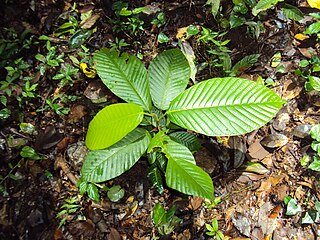
Dipterocarpus is a genus of flowering plants and the type genus of family Dipterocarpaceae.
Dipterocarpus acutangulus is a species of tree in the family Dipterocarpaceae. The species name acutangulus is derived from Latin and refers to the ribs of the fruit calyx tube. It is native to peninsular Thailand and Malaysia and also Borneo, where it is locally known as keruing merkah or keruing beludu. It is an emergent tree up to 60 m tall. The tree occurs in mixed dipterocarp forests found on sandy and sandy clay soils on coastal hills and inland ridges, up to 1000 m elevation. It occurs in at least one protected area.
Dipterocarpus costulatus is a species of tree in the family Dipterocarpaceae. It grows up to 50 metres (160 ft) tall.
Dipterocarpus elongatus is a species of tree in the family Dipterocarpaceae found in Indonesia, Malaysia and Singapore. This large tree occurs in secondary and primary forest, as well as in freshwater swamp forest.
Dipterocarpus eurhynchus is a species of tree in the family Dipterocarpaceae. The tree is found in Borneo, Sumatra, Peninsular Malaysia and the Philippines. This species occurs in mixed dipterocarp forest on leached clay soils.

Dipterocarpus gracilis is a critically endangered species of tree in the family Dipterocarpaceae, native to South Asia and Southeast Asia.
Dipterocarpus hasseltii is a species of tree in the family Dipterocarpaceae. This large tree occurs in lowland dipterocarp forest and is cut for keruing timber. It is found in Indonesia, Peninsular Malaysia, Sabah, the Philippines, Thailand and Vietnam.
Dipterocarpus kerrii is a species of tree in the family Dipterocarpaceae, native to the Andaman Islands, Sumatra, Borneo, Peninsular Malaysia, Laos, Myanmar, the Philippines, Singapore, Thailand and Vietnam.
Dipterocarpus semivestitus is a species of tree in the family Dipterocarpaceae, occurring in Kalimantan and peninsular Malaysia. This tree is almost always found in lowland forest on swampy land. It is very close to extinction.

Dipterocarpus grandiflorus is a species of flowering plant in the Dipterocarpaceae family. It is an endangered medium hardwood tree of Southeast Asia. It is a large tree which can grow up to 50 metres tall.

Dipterocarpus condorensis is a species of plant in the evergreen or semi-evergreen family Dipterocarpaceae.

Dipterocarpus alatus, also known colloquially as the resin tree, is a tropical forest tree, of dense evergreen or mixed dense forests, in tropical Asia. It is considered vulnerable.
Dipterocarpus dyeri (Khmer: rôyiëng, chhë tiël pruhs, chhë tiël th'nô:r, local name Kompong Thom: chhieutiel chgor, name used for commercial timber and the group of trees harvested for such: keruing, Vietnamese: Dầu Song Nàng, is a species of tree in the family Dipterocarpaceae found in Myanmar, Thailand, Peninsular Malaysia, Cambodia, Vietnam, and northwestern Borneo. The tree is found in rain forest and lowland semi-evergreen dipterocarp forests, an alternative habitat description is mixed dense forests of the plains, mainly among rivers and valleys. The tree is a climax or late successional species, which in some secondary forests forms relatively young pure colonies. The conservation status is based on rates of habitat loss, the major threat to the taxa, though in Vietnam it is cited as having a less threatened conservation status of Vulnerable.
Dipterocarpus fagineus grows as a medium-sized tree up to 45 metres (150 ft) tall, with a trunk diameter of up to 1 metre (3 ft). Bark is greyish brown. The fruits are roundish to ellipsoid, up to 1 cm (0.4 in) long. The specific epithet fagineus is from the Latin meaning "like a beech". Habitat is mixed dipterocarp forest on hills. D. fagineus is found in Sumatra, Peninsular Malaysia and Borneo.
Dipterocarpus kunstleri grows as a canopy tree up to 40 metres (130 ft) tall, with a trunk diameter of up to 1 metre. Bark is orange-brown. Fruit is ellipsoid, up to 5 centimetres (2.0 in) long. Habitat is mixed dipterocarp forest from sea-level to 400 metres (1,300 ft) elevation. D. kunstleri is found in Sumatra, Peninsular Malaysia, Borneo and the Philippines.
Dipterocarpus lowii is a tree in the family Dipterocarpaceae.
Dipterocarpus oblongifolius grows as a tree up to 30 metres (100 ft) tall, with a trunk diameter of up to 1.5 metres. Bark is greyish brown. The fruits are ovoid to spindle-shaped, up to 3 cm (1 in) long. The specific epithet oblongifolius is from the Latin meaning "oblong leaves". Habitat is river banks from sea-level to 400 metres (1,300 ft) elevation. D. oblongifolius is found in Thailand, Peninsular Malaysia and Borneo.
Dipterocarpus rigidus grows as a large tree up to 50 metres (160 ft) tall, with a trunk diameter of up to 1 metre. Bark is rust-brown. The fruits are roundish, up to 5 cm (2 in) in diameter. Habitat is mixed dipterocarp forest on low hills near coasts. D. rigidus is found in Sumatra, Peninsular Malaysia and Borneo.
Dipterocarpus sublamellatus grows as a large tree up to 70 metres (230 ft) tall, with a trunk diameter of up to 3 metres (10 ft). Bark is orange-brown. The fruits are round, up to 3 cm (1 in) in diameter. It is found in a variety of now vulnerable habitats from sea-level to 400 metres (1,300 ft) elevation. D. sublamellatus is native to Sumatra, Peninsular Malaysia and Borneo.





